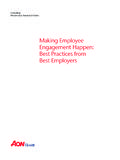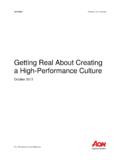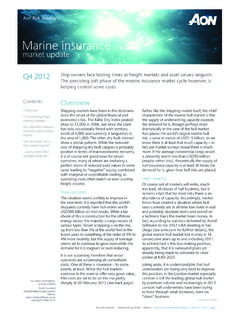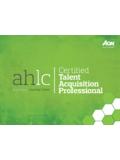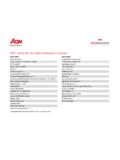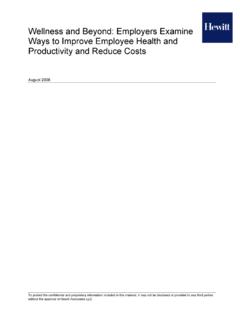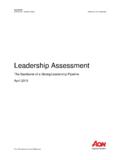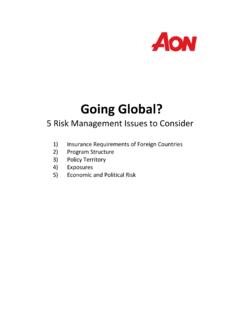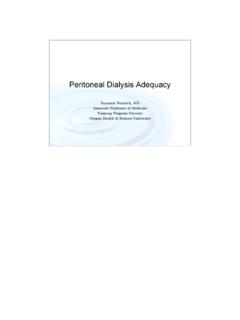Transcription of The Real Deal - Health | Aon
1 Consulting Consulting Retirement Talent & Rewards The real deal 2012 Retirement Income adequacy at Large Companies Highlights RETIREMENT. YOU ARE HERE. Study Highlights Retirement Income adequacy There is increasing concern over employees not having enough money to meet their retirement needs. Employees face the risk of having to work longer than desired or decreasing their living standards. Employers face workforce risks if employees are not able to retire as planned. And in light of growing deficits and economic difficulties, the country's social systems are at risk of becoming overwhelmed by retiring workers who are financially ill-prepared for retirement. To confront these risks, several key questions need to be addressed: Q How much do workers need to retire? Q Will employees be prepared for retirement if they continue doing what they are doing today?
2 Q What can employees and employers do to improve the outcomes? Aon Hewitt's real deal study answers these questions by studying the retirement resources and needs for million employees of 78 large US employers. The study projects employees' retirement resources and needs assuming their current behaviors continue. The report then analyzes the risks, measuring employer and employee actions to help improve the outcomes. The real deal study focuses on full-career contributing employees as the baseline. For this purpose, we define full career as an employee with the potential to work 30 years or more with their current employer prior to retirement. This allows analysis of the theoretical potential for delivering adequate retirement income through the plans and savings behaviors of today's environment, an analysis of projected risks, and possible solutions to help manage the risks.
3 Focusing on full-career contributing employees allows the study to analyze the effect of an employer's retirement benefits as if they were delivered through a full career, even if employees do not choose to work for a single employer for this length of time. The study also analyzes different segments of the population under multiple future scenarios. In doing so, the study addresses which employees may fare best, how plan design influences behavior, and how different future scenarios might impact retirement income. Key Findings Q times pay: An average full-career contributing employee needs this much at age 65, after Social Security, to expect to have sufficient assets to get through retirement. Q 85% replacement ratio: The pay replacement needed in the first year of retirement (foundation of times pay through retirement).
4 Q times pay shortfall: An average full-career contributing employee is expected to have times pay in resources at retirement, leaving this shortfall. 1 Aon Hewitt Results The real deal study shows that more employees are on track to retire with adequate retirement income when compared to prior studies. Projected retirement income shortfalls for the real deal full-career contributor population have improved on average, although only slightly (now times pay, down from ). Some of the reasons for this improvement include strong market returns in 2009 and 2010 (compared to the poor market returns of 2008, at the time of our last study), and continued retirement savings by most employees. Almost 30% of employees are now on track to retire comfortably at age 65. The study projects that the employees who currently contribute to their employers' savings plans and who retire at age 65 after a full career will, on average, accumulate retirement resources of times their pay.
5 These resources include accumulations of employee savings in their employers' defined contribution plans ( times pay), accumulations of employers' additions to defined contribution plans ( times pay), and defined benefit pensions ( times pay). The study does not reflect savings or other retirement assets outside of the employer-sponsored plans. Figure 1. Retirement Resources Versus Needs Baseline Full-Career Contributing Employees Defined Contribution Plan Employee Portion Defined Contribution Plan Employer Portion Defined Benefit Plan Retirement Income Surplus/(Shortfall). Private Retirement Needs Social Security Total Retirement Needs Private Shortfall Private Social Total Resources Needs Security Needs While significant, these resources fall 20% short of the average projected retirement needs of times pay at retirement for these employees.
6 Times pay represents the retirement resources needed to maintain preretirement living standards throughout an average life expectancy, after reflecting the expected value of Social Security benefits. Retirement Income adequacy at Large Companies: The real deal 2. In addition to the average times pay shortfall, the following graph shows a somewhat broad distribution of results among full-career contributing employees. 29% of these employees are expected to satisfy all of their financial needs through retirement. At the other end of the spectrum, about 21% of employees are expected to have a shortfall of more than 6 times pay at age 65. Individual circumstances such as retirement benefit plan details, individual savings plan behaviors, income levels, and gender all help explain some of the variation in results. Figure 2.
7 Distribution of Retirement Income Surplus/(Shortfall) Multiples of Final Pay Baseline Full-Career Contributing Employees Baseline Average = ( ). 2 or Greater 0 (2) ( ) (4) ( ) (6) ( ) (8) ( ) Less than (8) Full-career employees represent only about half of the total real deal population. Projections for the other half of the study employees, including mid-career hires and those not currently contributing to their defined contribution plans, reveal significantly worse results. When analyzing all employees in the real deal study, the average shortfall increases to times pay. Only about 15% of all million employees in the study have positioned themselves to have sufficient resources to meet their needs if they retire at age 65. Results for the general population would likely reveal even larger retirement income shortfalls, compared to the results of this study.
8 The real deal study uses data from large employers who generally provide larger retirement benefits and more robust employee communication about the need for retirement savings than smaller employers. Many circumstances have contributed to so many employees being at risk of having insufficient retirement income. Inadequate retirement savings represent the most basic cause of the projected shortfalls. A 25-year-old whose employer provides only a defined contribution plan needs a total annual contribution (employee plus employer) of approximately 15% of pay to retire at 65 with adequate resources. Employers without traditional pensions generally contribute about 6% of pay toward their employees' retirement each year. That means employees need to save about 9% of pay in each of the next 40 years in order to stay on track.
9 According to other Aon Hewitt research, total contributions into defined contribution plans, including employee and employer contributions, comprised of pay on average. If employees wait until age 30 to begin contributing, the total annual contribution needed increases to about 19% of pay, highlighting the importance of starting early. Within the entire real deal study population, only 1 in 10 under age 30. have 15% of pay or more each year in combined employee and employer contributions. 3 Aon Hewitt Saving To Versus Through Retirement To Retirement Through Retirement Total needs 85% times pay Social Security 29% times pay Private needs 56% times pay To retirement is the percentage of Through retirement is the multiple preretirement income a person needs of pay a person needs at retirement in the year of retirement to maintain to keep their standard of living their standard of living in that year.
10 Throughout the retirement years. To understand the findings, readers need to be familiar with how this study defines and calculates adequate retirement income. The calculation starts by assuming a participant will want to maintain their standard of living after retirement. Building on methodology established in the 1981 President's Commission on Pension Policy, we updated assumptions to reflect key findings from the Aon/Georgia State Replacement Ratio studies. Current income is adjusted for expected changes at retirement: elimination of retirement savings, changes in taxes, and changes in expenditures, including medical costs. Medical costs reflect the 2010 Patient Protection and Affordable Care Act (PPACA) provisions as they stand at the time this report was published. This methodology produces an average need in the first year of retirement of 85% of pay.
